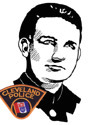END OF WATCH: March 24, 1921
Cleveland Police Department
August Dyke was appointed to the position of Patrol Officer on February 15, 1917 and was reputed to be one of the “best shots” in the department.
On February 20, 1921, while walking in the neighborhood, Mr. and Mrs. Ernest Jennings came upon a “robbery in progress.” During this time three gunmen were bent over a male stripping him of his personal possessions. The gunman noticed Mr. and Mrs. Jennings and proceeded to rob them. During this time, George Ohros, a neighbor of the Jennings, came upon this crime scene. George tried to escape this ordeal but was knocked down by a blow to the head. After the robbers fled, Mr. and Mrs. Jennings found Patrolmen Ball and Dyke. Patrolmen Dyke and Ball, both motorcycle policemen, set out in different routes to try and apprehend the suspects. Upon entering the area of E. 147th and Westropp Avenue, Dyke saw the suspects. While Dyke was apprehending these suspects, one turned and fired a shot at him, hitting Dyke in his chest. The patrolman proceeded to follow them, exchanging gunfire. One of the suspects was hit at this time, and Dyke went down simultaneously. The suspects managed to escape in an unknown direction.
Ptl. Dyke was rushed to Glenville Hospital, where he was listed in critical condition from a gunshot wound to the chest, with the bullet penetrating one lung. A city-wide search for the suspects then ensued. Capt. Matowitz, along with Detectives Keller, Zeman, Rezak and Soukup and Sgt. Hires of the Vice Squad, were assigned to the case.
While conducting their investigation, the police received information from citizens about a person with a gunshot wound being brought into a local pool-room during the middle of the night. The Vice Squad responded to this location and found a man later identified as Charles Habig lying hidden behind piles of discarded scenery and stage fixtures with a gunshot wound to the neck. The pool-room had been earlier used for a community theater. The suspect had a .38 caliber bullet lodged in the back of his neck and was half-conscious from pain and shock.
Charles Habig was arrested in connection with the shooting. During questioning, police learned Habig and two other males were almost caught in the act of robbery by Dyke. Habig’s arrest was followed one minute later by that of a Merton Herendeen, also a participant of the robbery. Herendeen appeared with a surgeon to treat Habig’s at the pool room five minutes before detectives had arrived.
The plan was to pick up Habig and transport him back to Mentor where he would have the bullet removed. Herendeen was arrested and also charged with shooting to kill Dyke. Habig was immediately transported to St. Mark’s Hospital where Dr. Brownlee made an X-ray of Habig’s neck and removed a .38 caliber bullet that matched the one fired from Dyke’s weapon in his attempt to apprehend the suspects.
During a brief interview, both suspects stated they had been approached Sunday evening by a male who showed them a revolver and invited them to join in with him in a series of holdups. They also stated it was the third male who shot Dyke while being pursued after the robbery. Both males were also charged with robbery and assault. The third suspect was later arrested.
Patrolman Dyke died from the effects of his wounds on March 24, 1921. He left behind a wife and three children.
During the trial Charles Habig pled guilty to 1st degree murder and threw himself on the mercy of the court. On June 9, 1921, Judge Bernon sentenced him to be electrocuted however, A stay of electrocution was asked and allowed.
On June 28, 1921 Christ Lonchar was found guilty of manslaughter because he was the suspect who wounded Dyke. The suspects were given indeterminate sentences in the Ohio State Penitentiary.
August Dyke’s name is inscribed on the National Law Enforcement Officers Memorial Wall, Washington, D.C. panel 51, east wall, line 10.
By Recruit Shelton E. White, Cleveland Police Academy
